turn signal SKODA FABIA 2004 1.G / 6Y User Guide
[x] Cancel search | Manufacturer: SKODA, Model Year: 2004, Model line: FABIA, Model: SKODA FABIA 2004 1.G / 6YPages: 247
Page 59 of 247
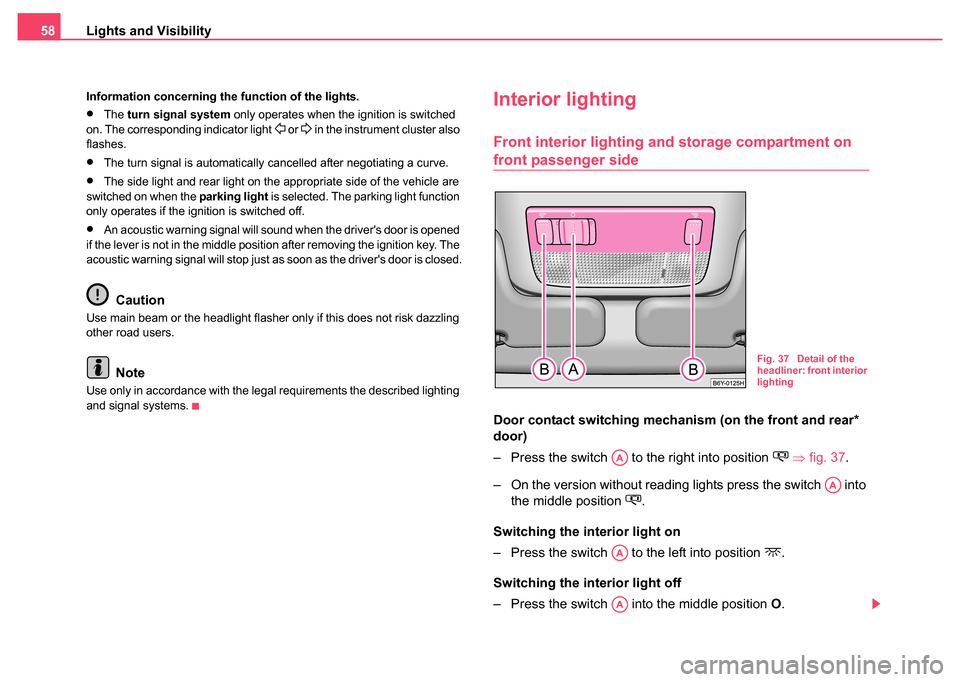
Lights and Visibility
58
Information concerning the function of the lights.
•The turn signal system only operates when the ignition is switched
on. The corresponding indicator light or in the instrument cluster also
flashes.
•The turn signal is automatically cancelled after negotiating a curve.
•The side light and rear light on the appropriate side of the vehicle are
switched on when the parking light is selected. The parking light function
only operates if the ignition is switched off.
•An acoustic warning signal will sound when the driver's door is opened
if the lever is not in the middle position after removing the ignition key. The
acoustic warning signal will stop just as soon as the driver's door is closed.
Caution
Use main beam or the headlight flasher only if this does not risk dazzling
other road users.
Note
Use only in accordance with the legal requirements the described lighting
and signal systems.
Interior lighting
Front interior lighting and storage compartment on
front passenger side
Door contact switch ing mechanism (on the front and rear*
door)
– Press the switch to the right into position
⇒ fig. 37 .
– On the version without reading lights press the switch into the middle position
.
Switching the interior light on
– Press the switch to the left into position
.
Switching the interior light off
– Press the switch into the middle position O.
Fig. 37 Detail of the
headliner: front interior
lighting
AA
AA
AA
AA
Page 107 of 247
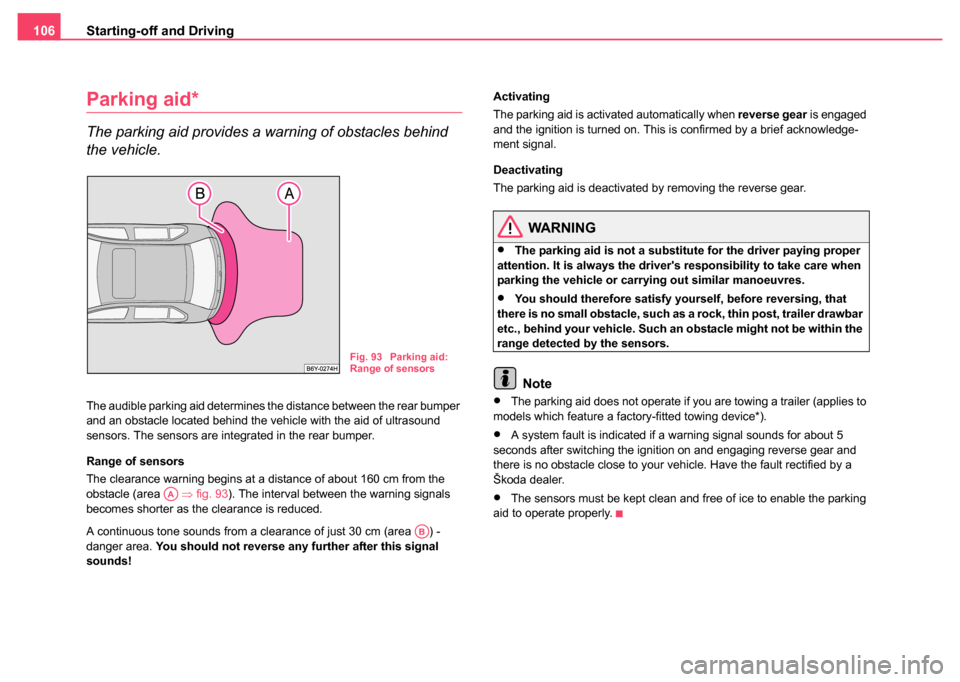
Starting-off and Driving
106
Parking aid*
The parking aid provides a warning of obstacles behind
the vehicle.
The audible parking aid determines the distance between the rear bumper
and an obstacle located behind the vehicle with the aid of ultrasound
sensors. The sensors are integrated in the rear bumper.
Range of sensors
The clearance warning begins at a distance of about 160 cm from the
obstacle (area ⇒fig. 93 ). The interval between the warning signals
becomes shorter as the clearance is reduced.
A continuous tone sounds from a clearance of just 30 cm (area ) -
danger area. You should not reverse any further after this signal
sounds! Activating
The parking aid is activated automatically when reverse gear
is engaged
and the ignition is turned on. This is confirmed by a brief acknowledge-
ment signal.
Deactivating
The parking aid is deactivated by removing the reverse gear.
WARNING
•The parking aid is not a substitute for the driver paying proper
attention. It is always the driver's responsibility to take care when
parking the vehicle or carrying out similar manoeuvres.
•You should therefore satisfy yourself, before reversing, that
there is no small obstacle, such as a rock, thin post, trailer drawbar
etc., behind your vehicle. Such an obstacle might not be within the
range detected by the sensors.
Note
•The parking aid does not operate if you are towing a trailer (applies to
models which feature a factory-fitted towing device*).
•A system fault is indicated if a warning signal sounds for about 5
seconds after switching the ignition on and engaging reverse gear and
there is no obstacle close to your vehicle. Have the fault rectified by a
Škoda dealer.
•The sensors must be kept clean and free of ice to enable the parking
aid to operate properly.
Fig. 93 Parking aid:
Range of sensors
AA
AB
Page 119 of 247

Passive Safety
118
should be observed when using the equipment and how you and the
people travelling with you can make full use of the existing safety equip-
ment. This Owner's Manual contains important warning notes, which you
and those travelling with you should pay attention to in order to reduce a
risk of injury.
Safety concerns everybody!
Before setting off
The driver is always fully responsible for his occupants
and for the operating safety of the vehicle.
For your own safety and the safety of the people travelling with you,
please pay attention to the following points before setting off.
•Ensure that the lighting and the turn signal system are functioning
properly.
•Inspect the tyre inflation pressure.
•Ensure that all the windows offer a good visibility to the outside.
•Safely attach the items of luggage ⇒page 72, “Loading the luggage
compartment”.
•Ensure that no objects can obstruct the pedal.
•Adjust the mirror, the front seat and the head restraint to match your
body size.
•Point out to your occupants that the head restraints must be adjusted
to match their body size.
•Protect the children in suitable child seats with correctly fastened seat
belts ⇒page 140, “Transporting children safely”.
•Adopt the correct seated position. Also inform your occupants to adopt
the correct seated position.
•Fasten the seat belt correctly. Also inform your occupants to properly
fasten the seat belts ⇒page 126, “How are seat belts correctly
fastened?”.
What influences the driving safety?
The driving safety is primarily determined by the style of
driving and the personal behaviour of all the occupants.
The driver is fully responsible for himself and his occupants. If your driving
safety is effected, you place yourself and the oncoming traffic at risk.
Please refer to the following guidelines.
•Do not get distracted from concentrating on the traffic situation, e.g. by
your occupants or mobile phone calls.
•Never drive when your driving ability is impaired, e.g. through medica-
tion, alcohol, drugs.
•Keep to the traffic regulations and the permissible speed limit.
•Adjust the driving speed at all times to the road condition as well as to
the traffic and weather conditions.
•Take regular breaks on long journeys - at the latest every two hours.
Page 221 of 247
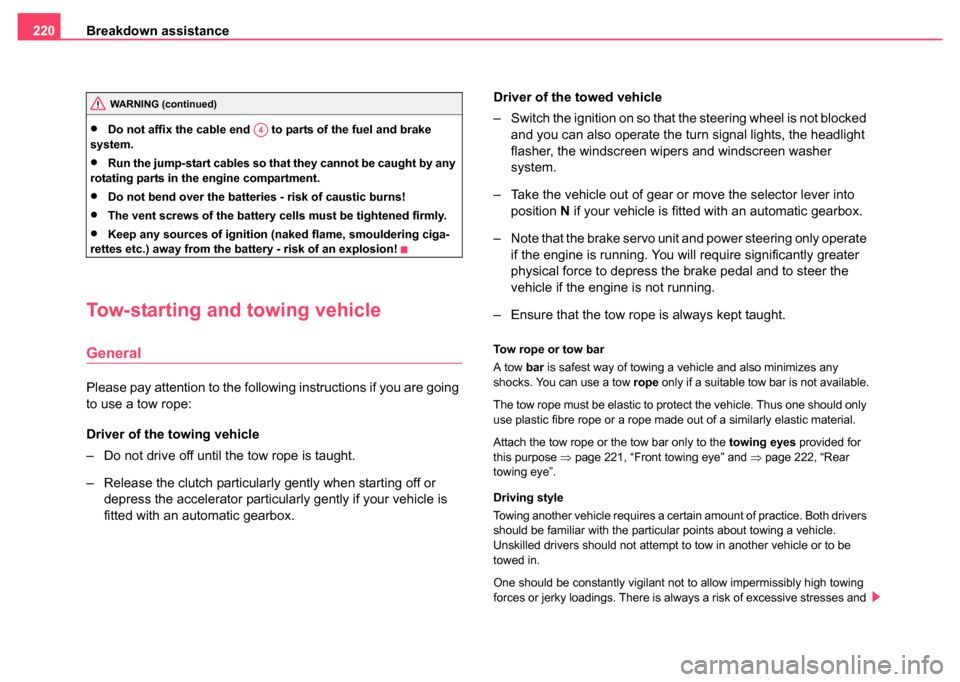
Breakdown assistance
220
•Do not affix the cable end to parts of the fuel and brake
system.
•Run the jump-start cables so that they cannot be caught by any
rotating parts in the engine compartment.
•Do not bend over the batteries - risk of caustic burns!
•The vent screws of the battery cells must be tightened firmly.
•Keep any sources of ignition (naked flame, smouldering ciga-
rettes etc.) away from the battery - risk of an explosion!
Tow-starting and towing vehicle
General
Please pay attention to the following instructions if you are going
to use a tow rope:
Driver of the towing vehicle
– Do not drive off until the tow rope is taught.
– Release the clutch particularly gently when starting off or depress the accelerator particularly gently if your vehicle is
fitted with an automatic gearbox. Driver of the towed vehicle
– Switch the ignition on so that the steering wheel is not blocked
and you can also operate the turn signal lights, the headlight
flasher, the windscreen wipers and windscreen washer
system.
– Take the vehicle out of gear or move the selector lever into position N if your vehicle is fitted with an automatic gearbox.
– Note that the brake servo unit and power steering only operate if the engine is running. You will require significantly greater
physical force to depress the brake pedal and to steer the
vehicle if the engine is not running.
– Ensure that the tow rope is always kept taught.
Tow rope or tow bar
A tow bar is safest way of towing a vehicle and also minimizes any
shocks. You can use a tow rope only if a suitable tow bar is not available.
The tow rope must be elastic to protect the vehicle. Thus one should only
use plastic fibre rope or a rope made out of a similarly elastic material.
Attach the tow rope or the tow bar only to the towing eyes provided for
this purpose ⇒ page 221, “Front towing eye” and ⇒page 222, “Rear
towing eye”.
Driving style
Towing another vehicle requires a certain amount of practice. Both drivers
should be familiar with the particular points about towing a vehicle.
Unskilled drivers should not attempt to tow in another vehicle or to be
towed in.
One should be constantly vigilant not to allow impermissibly high towing
forces or jerky loadings. There is always a risk of excessive stresses and
WARNING (continued)
A4
Page 227 of 247
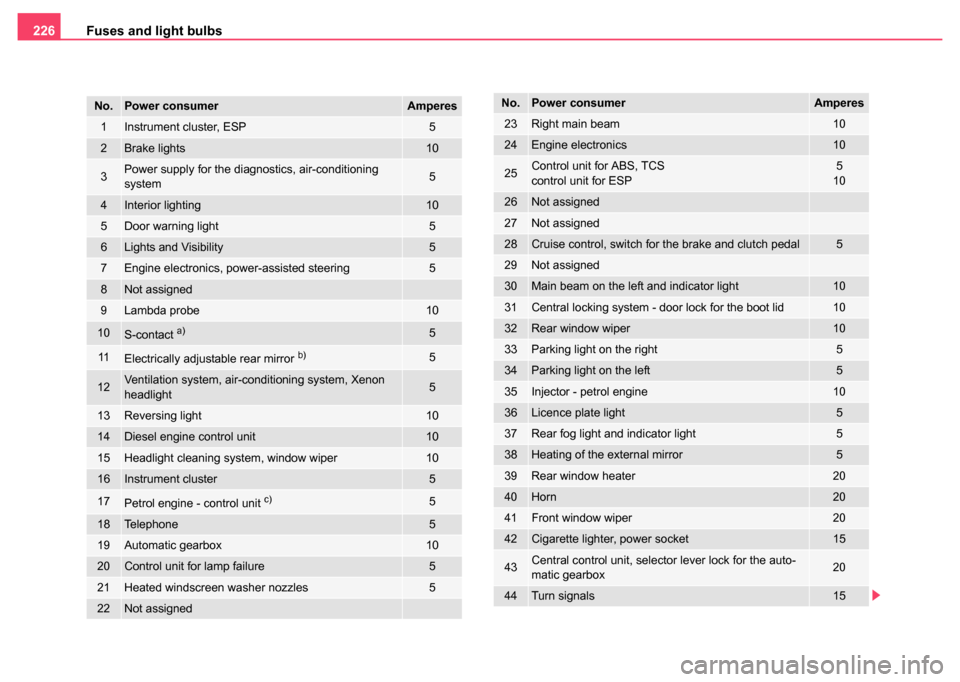
Fuses and light bulbs
226
No.Power consumerAmperes
1Instrument cluster, ESP5
2Brake lights10
3Power supply for the diagnostics, air-conditioning
system5
4Interior lighting10
5Door warning light 5
6Lights and Visibility5
7Engine electronics, power-assisted steering5
8Not assigned
9Lambda probe10
10S-contact a)5
11Electrically adjustable rear mirror b)5
12Ventilation system, air-conditioning system, Xenon
headlight5
13Reversing light10
14Diesel engine control unit10
15Headlight cleaning system, window wiper10
16Instrument cluster5
17Petrol engine - control unit c)5
18Telephone5
19Automatic gearbox10
20Control unit for lamp failure5
21Heated windscreen washer nozzles5
22Not assigned
23Right main beam10
24Engine electronics10
25Control unit for ABS, TCS
control unit for ESP5
10
26Not assigned
27Not assigned
28Cruise control, switch for the brake and clutch pedal5
29Not assigned
30Main beam on the left and indicator light10
31Central locking system - door lock for the boot lid10
32Rear window wiper10
33Parking light on the right5
34Parking light on the left5
35Injector - petrol engine10
36Licence plate light5
37Rear fog light and indicator light5
38Heating of the external mirror5
39Rear window heater20
40Horn20
41Front window wiper20
42Cigarette lighter, power socket15
43Central control unit, selector lever lock for the auto-
matic gearbox20
44Turn signals15
No.Power consumerAmperes
Page 229 of 247
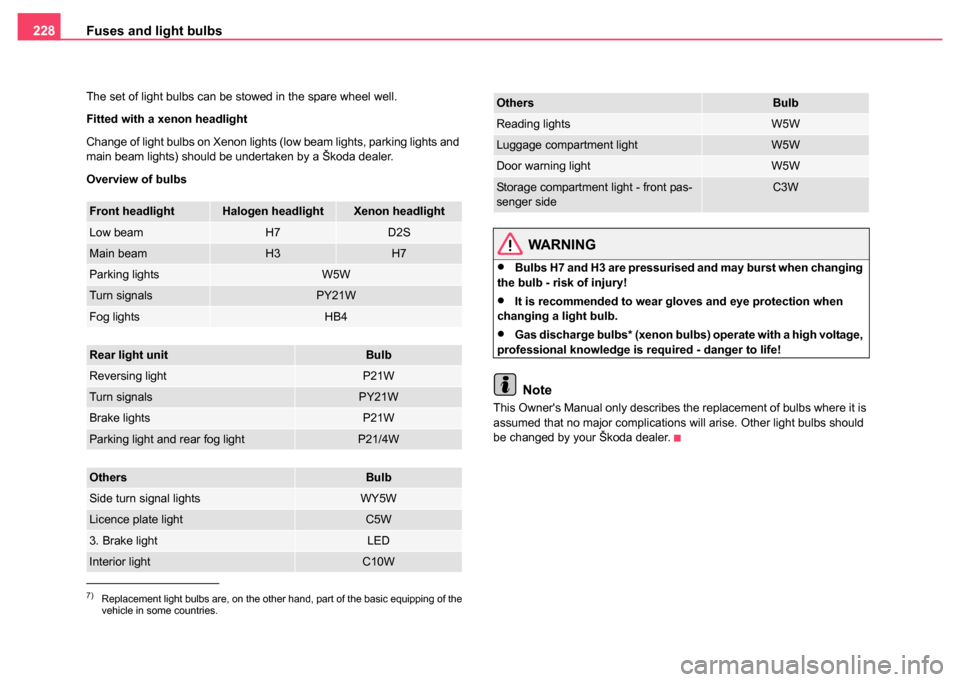
Fuses and light bulbs
228
The set of light bulbs can be stowed in the spare wheel well.
Fitted with a xenon headlight
Change of light bulbs on Xenon lights (low beam lights, parking lights and
main beam lights) should be undertaken by a Škoda dealer.
Overview of bulbs
WARNING
•Bulbs H7 and H3 are pressurised and may burst when changing
the bulb - risk of injury!
•It is recommended to wear gloves and eye protection when
changing a light bulb.
•Gas discharge bulbs* (xenon bulbs) operate with a high voltage,
professional knowledge is required - danger to life!
Note
This Owner's Manual only describes the replacement of bulbs where it is
assumed that no major complications will arise. Other light bulbs should
be changed by your Škoda dealer.
7)Replacement light bulbs are, on the other hand, part of the basic equipping of the
vehicle in some countries.
Front headlightHalogen headlightXenon headlight
Low beamH7D2S
Main beamH3H7
Parking lightsW5W
Turn signalsPY21W
Fog lightsHB4
Rear light unitBulb
Reversing lightP21W
Turn signalsPY21W
Brake lightsP21W
Parking light and rear fog lightP21/4W
OthersBulb
Side turn signal lightsWY5W
Licence plate lightC5W
3. Brake lightLED
Interior lightC10W
Reading lightsW5W
Luggage compartment lightW5W
Door warning lightW5W
Storage compartment light - front pas-
senger sideC3W
OthersBulb
Page 232 of 247
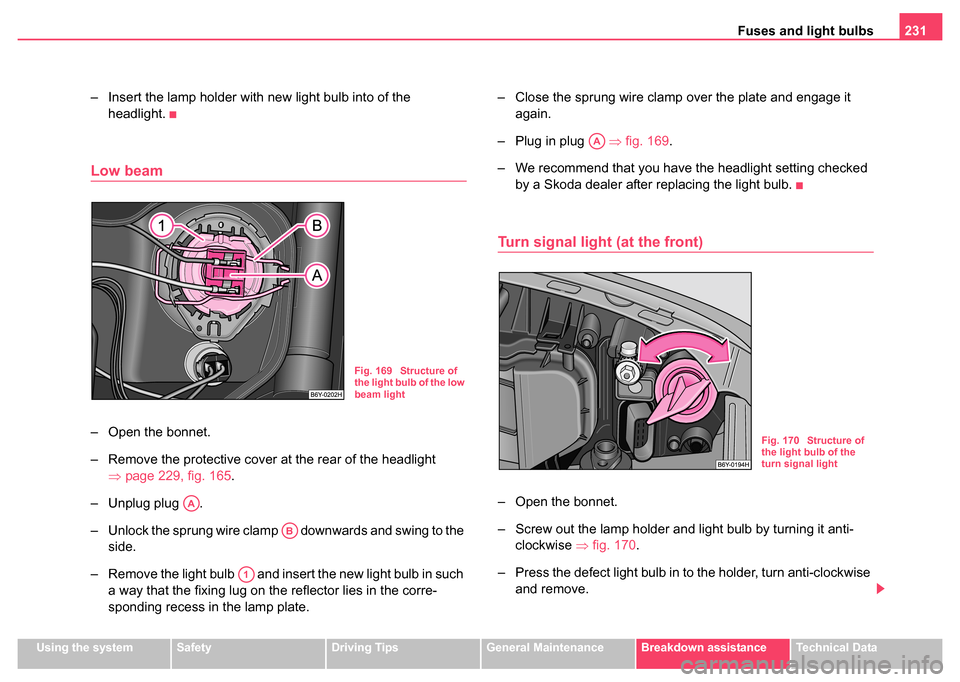
Fuses and light bulbs231
Using the systemSafetyDriving TipsGeneral MaintenanceBreakdown assistanceTechnical Data
– Insert the lamp holder with new light bulb into of the
headlight.
Low beam
– Open the bonnet.
– Remove the protective cover at the rear of the headlight ⇒page 229, fig. 165.
– Unplug plug .
– Unlock the sprung wire clamp downwards and swing to the side.
– Remove the light bulb and insert the new light bulb in such a way that the fixing lug on the reflector lies in the corre-
sponding recess in the lamp plate. – Close the sprung wire clamp over the plate and engage it
again.
– Plug in plug ⇒fig. 169 .
– We recommend that you have the headlight setting checked by a Skoda dealer after replacing the light bulb.
Turn signal light (at the front)
– Open the bonnet.
– Screw out the lamp holder and light bulb by turning it anti-clockwise ⇒fig. 170 .
– Press the defect light bulb in to the holder, turn anti-clockwise and remove.
Fig. 169 Structure of
the light bulb of the low
beam light
AA
AB
A1
AA
Fig. 170 Structure of
the light bulb of the
turn signal light
Page 244 of 247
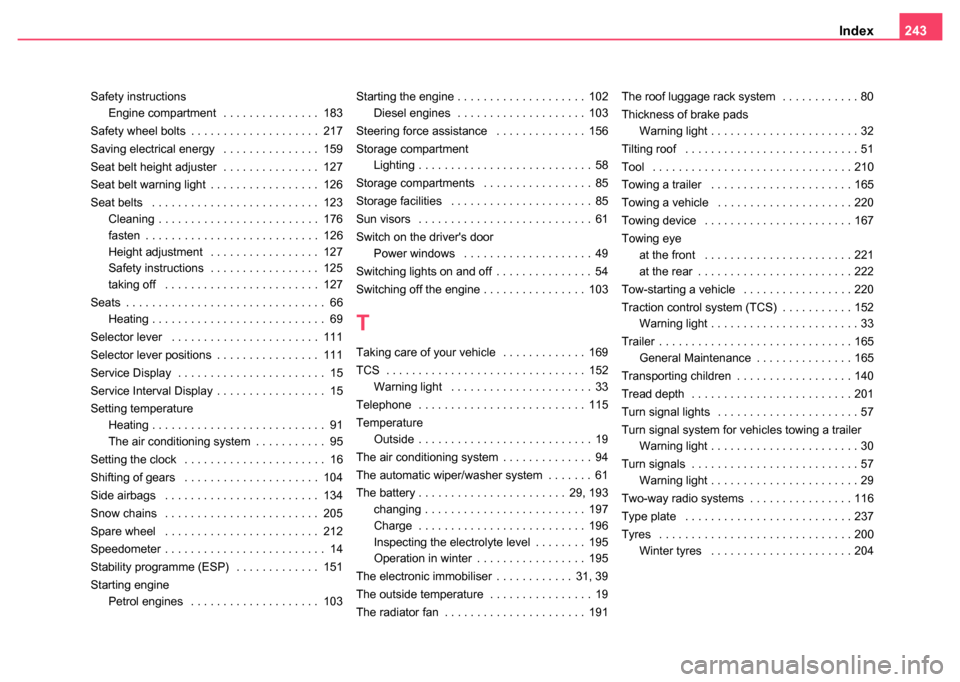
Index243
Safety instructions
Engine compartment . . . . . . . . . . . . . . . 183
Safety wheel bolts . . . . . . . . . . . . . . . . . . . . 217
Saving electrical energy . . . . . . . . . . . . . . . 159
Seat belt height adjuster . . . . . . . . . . . . . . . 127
Seat belt warning light . . . . . . . . . . . . . . . . . 126
Seat belts . . . . . . . . . . . . . . . . . . . . . . . . . . 123 Cleaning . . . . . . . . . . . . . . . . . . . . . . . . . 176
fasten . . . . . . . . . . . . . . . . . . . . . . . . . . . 126
Height adjustment . . . . . . . . . . . . . . . . . 127
Safety instructions . . . . . . . . . . . . . . . . . 125
taking off . . . . . . . . . . . . . . . . . . . . . . . . 127
Seats . . . . . . . . . . . . . . . . . . . . . . . . . . . . . . . 66 Heating . . . . . . . . . . . . . . . . . . . . . . . . . . . 69
Selector lever . . . . . . . . . . . . . . . . . . . . . . . 111
Selector lever positions . . . . . . . . . . . . . . . . 111
Service Display . . . . . . . . . . . . . . . . . . . . . . . 15
Service Interval Display . . . . . . . . . . . . . . . . . 15
Setting temperature Heating . . . . . . . . . . . . . . . . . . . . . . . . . . . 91
The air conditioning system . . . . . . . . . . . 95
Setting the clock . . . . . . . . . . . . . . . . . . . . . . 16
Shifting of gears . . . . . . . . . . . . . . . . . . . . . 104
Side airbags . . . . . . . . . . . . . . . . . . . . . . . . 134
Snow chains . . . . . . . . . . . . . . . . . . . . . . . . 205
Spare wheel . . . . . . . . . . . . . . . . . . . . . . . . 212
Speedometer . . . . . . . . . . . . . . . . . . . . . . . . . 14
Stability programme (ESP) . . . . . . . . . . . . . 151
Starting engine Petrol engines . . . . . . . . . . . . . . . . . . . . 103 Starting the engine . . . . . . . . . . . . . . . . . . . . 102
Diesel engines . . . . . . . . . . . . . . . . . . . . 103
Steering force assistance . . . . . . . . . . . . . . 156
Storage compartment Lighting . . . . . . . . . . . . . . . . . . . . . . . . . . . 58
Storage compartments . . . . . . . . . . . . . . . . . 85
Storage facilities . . . . . . . . . . . . . . . . . . . . . . 85
Sun visors . . . . . . . . . . . . . . . . . . . . . . . . . . . 61
Switch on the driver's door Power windows . . . . . . . . . . . . . . . . . . . . 49
Switching lights on and off . . . . . . . . . . . . . . . 54
Switching off the engine . . . . . . . . . . . . . . . . 103
T
Taking care of your vehicle . . . . . . . . . . . . . 169
TCS . . . . . . . . . . . . . . . . . . . . . . . . . . . . . . . 152 Warning light . . . . . . . . . . . . . . . . . . . . . . 33
Telephone . . . . . . . . . . . . . . . . . . . . . . . . . . 115
Temperature Outside . . . . . . . . . . . . . . . . . . . . . . . . . . . 19
The air conditioning system . . . . . . . . . . . . . . 94
The automatic wiper/washer system . . . . . . . 61
The battery . . . . . . . . . . . . . . . . . . . . . . . 29, 193 changing . . . . . . . . . . . . . . . . . . . . . . . . . 197
Charge . . . . . . . . . . . . . . . . . . . . . . . . . . 196
Inspecting the electrolyte level . . . . . . . . 195
Operation in winter . . . . . . . . . . . . . . . . . 195
The electronic immobiliser . . . . . . . . . . . . 31, 39
The outside temperature . . . . . . . . . . . . . . . . 19
The radiator fan . . . . . . . . . . . . . . . . . . . . . . 191 The roof luggage rack system . . . . . . . . . . . . 80
Thickness of brake pads
Warning light . . . . . . . . . . . . . . . . . . . . . . . 32
Tilting roof . . . . . . . . . . . . . . . . . . . . . . . . . . . 51
Tool . . . . . . . . . . . . . . . . . . . . . . . . . . . . . . . 210
Towing a trailer . . . . . . . . . . . . . . . . . . . . . . 165
Towing a vehicle . . . . . . . . . . . . . . . . . . . . . 220
Towing device . . . . . . . . . . . . . . . . . . . . . . . 167
Towing eye at the front . . . . . . . . . . . . . . . . . . . . . . . 221
at the rear . . . . . . . . . . . . . . . . . . . . . . . . 222
Tow-starting a vehicle . . . . . . . . . . . . . . . . . 220
Traction control system (TCS) . . . . . . . . . . . 152 Warning light . . . . . . . . . . . . . . . . . . . . . . . 33
Trailer . . . . . . . . . . . . . . . . . . . . . . . . . . . . . . 165 General Maintenance . . . . . . . . . . . . . . . 165
Transporting children . . . . . . . . . . . . . . . . . . 140
Tread depth . . . . . . . . . . . . . . . . . . . . . . . . . 201
Turn signal lights . . . . . . . . . . . . . . . . . . . . . . 57
Turn signal system for vehicles towing a trailer Warning light . . . . . . . . . . . . . . . . . . . . . . . 30
Turn signals . . . . . . . . . . . . . . . . . . . . . . . . . . 57 Warning light . . . . . . . . . . . . . . . . . . . . . . . 29
Two-way radio systems . . . . . . . . . . . . . . . . 116
Type plate . . . . . . . . . . . . . . . . . . . . . . . . . . 237
Tyres . . . . . . . . . . . . . . . . . . . . . . . . . . . . . . 200 Winter tyres . . . . . . . . . . . . . . . . . . . . . . 204